
On this day in Tudor history, 3rd May 1580, poet, farmer and agricultural writer Thomas Tusser died.
I mark the anniversary of his death by sharing with you his verses for the month of May.
[Read More...]
On this day in Tudor history, 3rd May 1580, poet, farmer and agricultural writer Thomas Tusser died.
I mark the anniversary of his death by sharing with you his verses for the month of May.
[Read More...]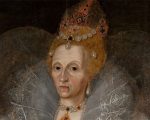
On this day in history, 28th April 1603, the last Tudor monarch, Queen Elizabeth I, was laid to rest at Westminster Abbey in a lavish funeral.
In today’s video, I share an excerpt from my book “On This Day in Tudor History” about Elizabeth I’s burial and resting place.
[Read More...]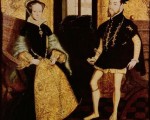
On this day in Tudor history, 25 April 1557, Tudor troublemaker Thomas Stafford, grandson of Margaret Pole, Countess of Salisbury, proclaimed himself "Protector of the Realm". It didn't go down well!
Find out why he did this, what happened and how it wasn't his first brush with trouble, in today's video
Also on this day in history:
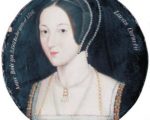
On this day in Tudor history, 12th April 1533, Anne Boleyn made her very first public appearance as King Henry VIII’s official queen consort.
Anne made quite an entrance! Accompanied by sixty ladies and “loaded with jewels”, she processed to Easter Eve mass at Greenwich Palace, setting tongues wagging.
Hear an account of this event in today’s video.
[Read More...]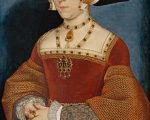
On this day in Tudor history, 1st April 1536, the imperial ambassador passed on information he’d received from two separate sources to his master, Emperor Charles V. The news was regarding Henry VIII and his behaviour towards one of his wife’s ladies-in-waiting, a certain Jane Seymour.
Find out exactly what happened, what Henry and Jane were up to, and how long this had been going on, in today’s video.
[Read More...]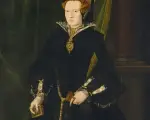
On this day in Tudor history, 29th March 1551, Mary Dudley married Henry Sidney. Happy anniversary to Mary and Henry!
Both Mary and Henry served Queen Elizabeth I loyally and for many years, and, unfortunately, Mary suffered a great deal after she nursed the queen through smallpox in 1562.
Find out more about Mary Dudley and Henry Sidney in today’s video.
[Read More...]
Today is the anniversary of the death of the iconic Queen Elizabeth I, daughter of King Henry VIII and his second wife, Anne Boleyn, and a woman who is known as the Virgin Queen, Gloriana and Good Queen Bess, and whose reign has been called a Golden Age.
In today's video, I talk about Elizabeth's last days and share contemporary accounts of her death on 24th March 1603. I also share some of Queen Elizabeth I's achievements.
There are lots of resources on Elizabeth I on the Tudor Society and you can find others by using the search box.
And if you only have 60 seconds to spare!
Also on this day in history:
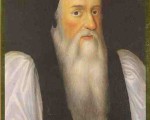
On this day in Tudor history, 21st March 1556, Thomas Cranmer, the former Archbishop of Canterbury, was burned at the stake in Oxford.
Cranmer had served Henry VIII and Edward VI as Archbishop of Canterbury and had played a leading role in the Reformation, but he was, of course, seen as a heretic in the reign of the Catholic Queen Mary I.
In today's video, I share John Foxe's account of Thomas Cranmer's end.
You can find out more about Thomas Cranmer here.
Also on this day in history:
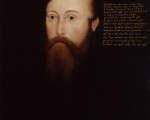
On this day in Tudor history, 20th March 1549, Thomas Seymour, 1st Baron of Sudeley, was executed by beheading on Tower Hill.
In today’s video, I talk about his execution and share the poem he wrote in his last days. I also give details of how some of Seymour’s contemporaries viewed him.
[Read More...]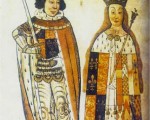
On this day in Tudor history, 16th March 1589, two Roman Catholic priests, Robert Dalby and John Amias, were executed as traitors at York.
Let me tell you about these men and what led to their very brutal executions. I also give an eye-witness account of their executions – sorry!
[Read More...]
On this day in Tudor history, 14th March 1540, Sir John Port died at Bewdley. Unfortunately, he’s not remembered for his intelligence, his work or even his legal notes, which were published in the 20th century. No, he’s remembered for mumbling in a case and changing the outcome! Oh dear!
I explain what happened and share more information on this man.
[Read More...]
On this day in Tudor history, 5th March 1549, a bill of attainder was passed against Thomas Seymour, Baron Sudeley, uncle of King Edward VI, finding him guilty of 33 counts of treason.
In today’s video, I explain what happened and share some of the charges laid against this brother of Queen Jane Seymour.
[Read More...]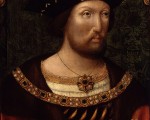
In today’s “on this day in Tudor history” video, I look at the Shrovetide joust, which took place on 2nd March 1522, and share Edward Hall’s wonderful account of the knights’ costumes and their mottoes.
Was the theme of unrequited love aimed at anyone in particular?
[Read More...]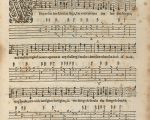
On this day in history, 1st March 1620, Tudor poet, composer and physician Thomas Campion died and was laid to rest.
Campion was a prolific composer and poet, yet he died in quite humble circumstances. He did, however, escape imprisonment and worse after being implicated in a man’s poisoning. Find out more about this man in this video.
[Read More...]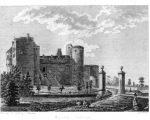
On this day in Tudor history, 28th February 1525, the wizard earl, Gerald Fitzgerald, 11th Earl of Kildare, was born. He spent much of his life on the run, and I explain why and what happened.
Fitzgerald is recorded as dying in London of a natural death, but legend says otherwise! Find out about the legend regarding him dabbling in the dark arts and his ghost at Kilkea Castle.
[Read More...]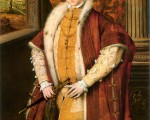
On this day in Tudor history, 20th February 1547, the boy-king Edward VI was crowned king by Archbishop Thomas Cranmer at Westminster Abbey.
In today’s video, I share details of Edward’s coronation, including the changes made due to his youth – the king was just nine years old. He needed cushions on his throne!
[Read More...]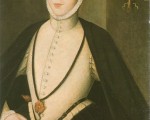
On 10th February 1567, Henry Stuart, Lord Darnley, second husband of Mary, Queen of Scots, was murdered at Kirk o’Field in Edinburgh. In today’s video, I tell you what happened.
[Read More...]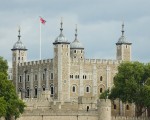
On this day in Tudor history, 9th February 1542, Jane Boleyn, Lady Rochford, was rowed to the Tower of London in preparation for her forthcoming execution. In today’s video, I explain why she wasn’t already at the Tower and where she’d been between her arrest in November 1541 and this day in 1542.
[Read More...]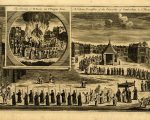
On this day in Tudor history, the remains of reformers Martin Bucer and Paul Fagius were exhumed and publicly burned in Cambridge, after the men were posthumously found guilty of heresy. I tell you more in this video:
[Read More...]
In today’s video, I read an excerpt from my book “On This Day in Tudor History” about an event which happened on 3rd February 1587 and which was connected to Mary, Queen of Scots.
[Read More...]
In today’s video, I talk about the Feast of Candlemas and the traditions associated with it.
[Read More...]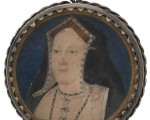
On this day in Tudor history, Henry VIII’s first wife, Catherine of Aragon, was buried at Peterborough Abbey.
[Read More...]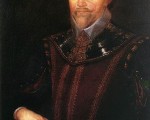
Sir Francis Drake died on this day in Tudor history in 1596, but who was he? I share some Francis Drake facts and two legends that surround this colourful man.
[Read More...]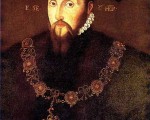
In today’s “on this day in Tudor history” video, I take you back to 1552 and the execution of Edward Seymour, Lord Protector.
[Read More...]
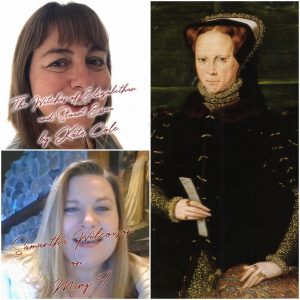 I just wanted to remind you about January's live chats for Tudor Society members.
I just wanted to remind you about January's live chats for Tudor Society members.
Our expert speaker for December was historian Kate Cole. Her talk was about witches in Elizabethan and Stuart Essex, a fascinating topic. Kate will be joining us in the chatroom tomorrow (Friday 4th January) to answer your questions in a live chat session. If you haven't watched her video talk yet, you can view it at https://www.tudorsociety.com/expert-talk-the-witches-of-elizabethan-and-stuart-essex-kate-cole/.
Our live chats take place in the Tudor Society chatroom at https://www.tudorsociety.com/chatroom/.
Here are the times for Kate's chat in different time zones:
Our expert speaker for this month is Samantha Wilcoxson, author of The Plantagenet Embers series of historical novels. Her talk is on Mary I, the subject of her novel Queen of Martyrs: The Story of Mary I and you can catch her talk at https://www.tudorsociety.com/expert-talk-mary-i-samantha-wilcoxson/. Samantha will be joining us in the chatroom on 25th January.
Here are the times in different time zones:
Our informal live chat in January is also on Mary I and will give you chance to share your views on the woman who has gone down in history as "Bloody Mary". That chat will take place on 11th January.
Here are the times in different time zones:
I do hope you can come to our chats, they're always fun and it's so good to talk Tudor.
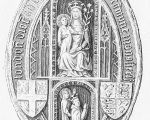
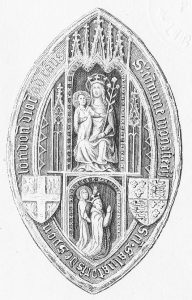
Engraving of original seal of the Abbess and Convent of Syon, Isleworth
On this day in history, 19th December 1576, Katherine Palmer, Abbess of Syon, died in Mechelen. Katherine and her nuns had fled from England to the Low Countries in 1559, following the accession of the Protestant queen, Elizabeth I, and had finally settled at Mechelen. There, on 8th November 1576, a mob of Calvinists broke into the monastery and the courageous abbess confronted them. It is thought that confronting the mob, a traumatic response, led to her death just over a month later, on 19th December. She was laid to rest at Mechelen in the Church of the Augustinians.
I dug a little into Katherine Palmer and her order. I found that she was of a gentry background and had given up that life to join the Bridgettine Order at Syon Monastery, in the parish of Isleworth, which had been founded by Henry V in 1415 and that had a reputation for its pious monastic life. Unfortunately, the abbey was dissolved in 1539 as part of the Dissolution of the Monasteries. However, the sisters kept their monastic life in small groups, one of which was led by Katherine.
In 1551, Katherine and six nuns and four brothers relocated to Termonde in the Low Countries. They returned to England in 1555, in the reign of the Catholic queen, Mary I, at Cardinal Pole's urging, and refounded Syon. Katherine was elected as abbess. As I said earlier, they fled England in 1559, moving to Termonde and then Antwerp and on to Mechelen, where Katherine died in 1576.
In his article for the Telegraph, Christopher Howse writes of how the order "went through astonishing sufferings from poverty and war, seeking refuge in France and Portugal" before finally settling back in England in 1861. In 1925, the order settled at South Brent, in Devon.
What is amazing is that they are the only surviving pre-Reformation religious community in England - wonderful!
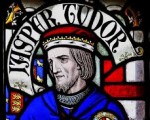
17th December:
1538 – Pope Paul III announced the excommunication of Henry VIII.
1550 – Birth of Henry Cavendish, soldier, traveller and son of Bess of Hardwick and Sir William Cavendish. He was married to Grace Talbot, daughter of George Talbot, 6th Earl of Shrewsbury. This match was arranged by his mother who had married the Earl of Shrewsbury.
1559 – Matthew Parker was consecrated as Elizabeth I’s Archbishop of Canterbury. According to “The Correspondence of Matthew Parker”, Anne Boleyn charged him with the care of Elizabeth when she saw him in April 1536, “not six days before her apprehension”. Historian Eric Ives writes that this was a request that Parker never forgot, and something which stayed with him for ever. Parker obviously came to be important to Elizabeth, because she made him her Archbishop of Canterbury in 1559. It was a post which Parker admitted to Lord Burghley, he would not have accepted if he “had not been so much bound to the mother”. Parker was Archbishop until his death in 1575.

 Tomorrow, Saturday 15th December, is time for the party of all parties, the Tudor Society Christmas party! Yay! I can't promise you bad Christmas music, or lots of food and drink, but I can promise you an hour of lovely socialising with some very friendly like-minded people.
Tomorrow, Saturday 15th December, is time for the party of all parties, the Tudor Society Christmas party! Yay! I can't promise you bad Christmas music, or lots of food and drink, but I can promise you an hour of lovely socialising with some very friendly like-minded people.
How does our Christmas party work?
Well, we all pile into the Tudor Society chatroom and chat. You can dress up for it if you like (I might wear my Christmas jumper!) and why don't you bring along your favourite Christmas tipple and snack? It's always fun to share what we're eating and drinking. Then we just chat. You can talk Tudor if you like, ask other members how they celebrate Christmas, anything really! They're always good fun. The party is open to all Tudor Society full access members plus our magazine subscribers.
Here are the times in different time zones:
You can find the chatroom at https://www.tudorsociety.com/chatroom/.
I have some other dates for your diaries too!
As you know, our expert speaker for December is historian Kate Cole. Her talk is about witches in Elizabethan and Stuart Essex, a fascinating topic. Kate will be joining us in the chatroom to answer your questions in a live chat session on 4th January 2019. That gives you plenty of time to view her video - https://www.tudorsociety.com/expert-talk-the-witches-of-elizabethan-and-stuart-essex-kate-cole/ - if you haven't had chance yet.
Here are the times in different time zones:
Our expert speaker for January is Samantha Wilcoxson, author of The Plantagenet Embers series of historical novels. She will be speaking to us on Mary I, the subject of her novel Queen of Martyrs: The Story of Mary I. She will be joining us in the chatroom on 25th January.
Here are the times in different time zones:
Our informal live chat in January is also on Mary I and will give you chance to share your views on the woman who has gone down in history as "Bloody Mary". That chat will take place on 11th January.
Here are the times in different time zones:
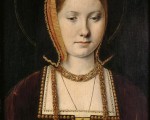
10th December:
1541 – Thomas Culpeper, Gentleman of the Privy Chamber, and Francis Dereham, a member of Queen Catherine Howard’s household, were executed at Tyburn. Culpeper and Dereham were tried on 1st December 1541 at the Guildhall, and convicted of treason. Both were executed on 10th December 1541, but Culpeper was beheaded while Dereham had to face the brutal traitor’s death of being hanged, drawn and quartered. Culpeper was buried at St Sepulchre-without-Newgate (Holborn).
1591 – Executions of Edmund Gennings, Roman Catholic priest, and Swithin Wells, Roman Catholic, on a scaffold set up outside Wells’ house at Holborn. They were hanged, drawn and quartered for treason due to their Catholic faith and for celebrating the mass.